VicSuper CIO Andrew Howard speaks about how stakeholder management is not simply about piling on the information. If boards receive too much data, it all becomes just noise, he says.
Register to Access this Exclusive [i3] Insights Article
Create a free account to access exclusive interviews with asset owners, revealing insights on investment strategies, market trends, and portfolio allocations.
If you already have an account you can Login .
If you have any issues registering an account please send us an email at [email protected].


